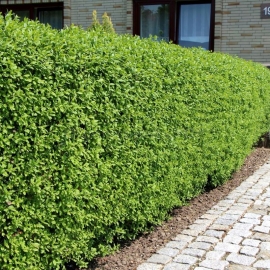 SALE
SALE






Organic Wild Privet Seeds (Ligustrum Vulgare)
1.00 €
1.39 € (Discount: 28%)
Wild Privet is a very popular semi evergreen/deciduous variety (it will lose some leaves in frosty weather). This is the variety that is most often included in mixed native hedges to give some element of evergreen cover in Winter.
-
Organic Wild Privet (Ligustrum Vulgare)
Wild Privet is a very popular semi evergreen/deciduous variety (it will lose some leaves in frosty weather). This is the variety that is most often included in mixed native hedges to give some element of evergreen cover in Winter (whereas the Common Privet and Japanese Privet varieties are more usually used in suburban settings) and very useful to provide lots of nest sites for wild birds.
This variety has smaller (than the other varieties) creamy white flowers in spring, popular with butterflies and birds. It is suitable for all soils apart from wet sites. Leaves and flowers are harmful if eaten.
How to Grow
Wild Privet seeds have a deep dormancy within them, this requires a degree of patience to overcome and it is usually quite easy to get high levels of germination if the correct procedures are followed.
First prepare a free draining substrate into which the seeds are to be mixed, this can be a 50/50 mixture of compost and sharp sand, or perlite, vermiculite or even just pure sharp sand has worked well for me. The chosen substrate needs to be moist (but not wet), if you can squeeze water out of it with your hand it is too wet and your seeds may drown and die. Mix the seeds into the substrate, making sure that their is enough volume of material to keep the seeds separated.
Place the seed mixture into a clear plastic bag (freezer bags, especially zip-lock bags are very useful for this -provided a little gap is left in the seal for air exchange) If it is not a zip-lock type bag it needs to be loosely tied. Then write the date on the bag so that you know when the pretreatment was started.
The seeds require a cold period to break the dormancy that is naturally found within them, this is easily achieved by placing the prepared bag of seeds and compost mix in the fridge (4 Celsius or 39F) for 8 weeks. It is quite possible for the seeds to germinate in the bag at these temperatures when they are ready to do so, if they do, just remove them from the bag and carefully plant them up. Seeds that are ready to germinate will have become plump and soft.
For small quantities I tend to just leave the seeds in the fridge and remove the germinated ones as they arise and plant them up. I find that this way you can get the maximum number to germinate. After a few months any remaining ungerminated seeds can have the cold pretreatment process repeated again- several times if necessary.
For larger quantities it is easiest to sow the seeds in a well prepared seedbed once the cold pretreatment has finished and wait for the seeds to germinate. Seeds that are ready to germinate will be plump and soft, if they are not, the pretreatment is not yet complete or has been ineffective due to incorrect temperatures or incorrect moisture content of the pretreatment medium.
Do not expose newly sown seeds to high temperatures (above 25 Celsius) otherwise a secondary dormancy may be induced and the seeds will not germinate until they have been pretreated again. Germinated seeds can be planted in deep pots or plug trays in a good quality compost. Keep the seedlings well watered and weed free.
Growth in the first year is usually between 15 and 40cm and and usually trouble free. Allow them to grow for 1 or 2 years before planting them in a permanent position.
